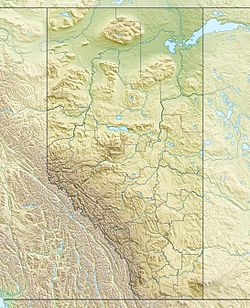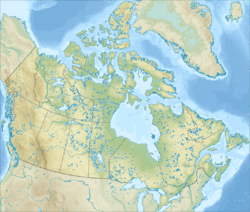Hays, Alberta facts for kids
Quick facts for kids
Hays
|
|
|---|---|
| Country | Canada |
| Province | Alberta |
| Region | Southern Alberta |
| Census division | 2 |
| Municipal district | Municipal District of Taber |
| Government | |
| • Type | Unincorporated |
| Area
(2021)
|
|
| • Land | 1.51 km2 (0.58 sq mi) |
| Population
(2021)
|
|
| • Total | 196 |
| • Density | 130/km2 (300/sq mi) |
| Time zone | UTC−07:00 (MST) |
| • Summer (DST) | UTC−06:00 (MDT) |
| Area code(s) | 403, 587, 825 |
Hays is a small community, called a hamlet, located in southern Alberta, Canada. It's part of the Municipal District of Taber. You can find Hays where Highway 524 and Highway 875 meet. It sits between the towns of Vauxhall and Redcliff.
The Bow River is about 3.3 kilometers (2.1 miles) north of Hays. The Oldman River is about 19 kilometers (12 miles) to the south. These two rivers join together to form the South Saskatchewan River about 20 kilometers (12 miles) southeast.
Hays was named after David Walker Hays (1878–1958). He was a chief engineer and manager for the Canada Land and Irrigation Company for many years. Hays celebrated its 50th anniversary in 2002, marking a special milestone.
Contents
History of Hays
Early Days and Ranching
In the late 1800s and early 1900s, the area around Hays was mostly used for ranching. It was covered in short-grass prairie, perfect for grazing cattle.
Bringing Water to the Land
As early as 1912, people started building canals and irrigation systems. These systems were designed to bring water from the Bow River to the dry land. However, the land wasn't actually irrigated until 1952.
This happened after the PFRA (Prairie Farm Rehabilitation Administration) bought the company that owned the irrigation system. The PFRA was a government agency focused on helping farms in the prairies.
Developing the Irrigation Project
From 1950, the PFRA began a five-year plan. They fixed up and expanded the existing irrigation system. They also helped farmers move to and settle in the area.
The PFRA managed this area as part of the Bow River Irrigation Project. In 1974, a new group called the Bow River Irrigation District took over. They now operate and maintain the irrigation works.
Today, about 33,000 acres (130 square kilometers) of land near Hays are irrigated. This means water is supplied to help crops grow.
Unique Land Design
One interesting thing about the land in Hays is how it's divided. Instead of perfectly square sections, the land parcels have irregular shapes. This design was chosen by engineers to save money on development. It also helped manage water flow and drainage better.
Population of Hays
Recent Population Changes
In 2021, Statistics Canada counted the population of Hays. There were 196 people living in 79 homes. This was an increase from 150 people in 2016.
The land area of Hays is 1.51 square kilometers (0.58 square miles). This means there were about 130 people per square kilometer in 2021.
Past Population Figures
In 2016, Hays had a population of 150 people. They lived in 68 homes. This was also an increase from 115 people in 2011.
The land area in 2016 was 1.54 square kilometers (0.59 square miles). The population density was about 97 people per square kilometer.
The Municipal District of Taber also conducts its own counts. Their 2016 census showed 163 people in Hays. This was the same number as their 2013 census.



